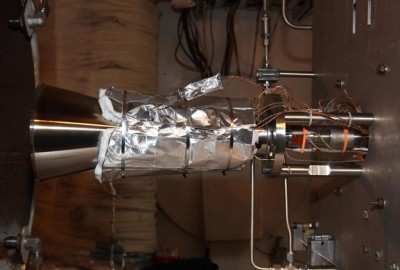Mon, Apr 04, 2011
Program Supports NASA's Orion Crew Exploration Vehicle
Vibration and hot fire acceptance testing has been completed on
the first development MR-104G mono-propellant rocket engine planned
for use on NASA's Orion Crew Module (CM). The engine is being
developed by Aerojet in conjunction with Lockheed Martin and NASA.
Twelve of the 160-lb. thrust MR-104G engines, arranged in four
single-engine pods and four dual-engine pods, provide the full
complement of primary and redundant control required for critical
maneuvers upon re-entry into the atmosphere.

Photo Courtesy AeroJet
Completion of the MR-104G acceptance testing was a critical
milestone in the development of the Orion crew module propulsion
system. This verification engine will be used to demonstrate
Orion-specific performance and life requirements in support of the
spacecraft's initial orbital flight.
The acceptance test successfully demonstrated several new design
features for the MR-104 engine including a newly developed 120 volt
series-redundant propellant valve, a 120 volt/40 watt catalyst bed
heater, a new chamber pressure transducer and an integral thruster
mount configuration. Aerojet completed these modifications to
support Orion's shock and vibration environment requirements.
The MR-104 engine family originally provided in-space propulsion
for the Voyager 1 and 2 and Magellan missions. Subsequent MR-104
variants provided propulsion for Landsat and NOAA as well as for
other U.S. government programs. "This testing success is a
culmination of great teamwork on the design and risk reduction
efforts," said Aerojet Orion Program Manager, Kim Wierenga. "It is
exciting to reach a point where Aerojet is verifying several new
design features that enable this thruster to fly on Orion's first
flight."

Lockheed Martin is the prime contractor to NASA for the Orion
crew exploration vehicle, which is being developed as the nation's
next generation spacecraft for future human exploration throughout
our solar system. Aerojet is part of the nationwide Orion industry
team led by Lockheed Martin, which includes five major
subcontractors and a nationwide network of minor subcontractors and
small businesses across the country.
More News
Aero Linx: Model Aeronautical Association of Australia MAAA clubs are about fun flying, camaraderie and community. For over 75 years, the MAAA has been Australia’s largest fl>[...]
Touchdown Zone Lighting Two rows of transverse light bars located symmetrically about the runway centerline normally at 100 foot intervals. The basic system extends 3,000 feet alon>[...]
“Discovery and innovation are central to our mission at Virgin Galactic. We’re excited to build on our successful record of facilitating scientific experiments in subor>[...]
How To Get A Story On Aero-TV News/Feature Programming How do I submit a story idea or lead to Aero-TV? If you would like to submit a story idea or lead, please contact Jim Campbel>[...]
Student Pilot Reported That During Rotation, “All Of A Sudden The Back Of The Plane Kicked To The Right..." Analysis: The student pilot reported that during rotation, “>[...]
 ANN's Daily Aero-Linx (05.02.24)
ANN's Daily Aero-Linx (05.02.24) ANN's Daily Aero-Term (05.02.24): Touchdown Zone Lighting
ANN's Daily Aero-Term (05.02.24): Touchdown Zone Lighting Aero-News: Quote of the Day (05.02.24)
Aero-News: Quote of the Day (05.02.24) ANN FAQ: Contributing To Aero-TV
ANN FAQ: Contributing To Aero-TV NTSB Final Report: Cirrus Design Corp SR20
NTSB Final Report: Cirrus Design Corp SR20



